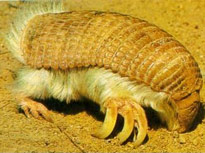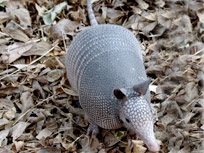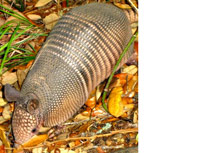Cingulata -- Armored Ambulating Armadillos



Origins
This is the only mammal that has armor plating. Look, I know rhinos and elephants look formidably skinned but I woudn't recommend the reader go up to either of those beasts and go "tickle! tickle!". Things would go rapidly south for you as those are touchy beasts. Anyway, Armadillo means "armored little thing" in Spanish and these creatures, both living and extinct have the most impressive armor-plating among mammals.
The animals in this order have been recorded in the legends, folklore and art of the Americas since ancient times. The Maya believed that they were created because of some in-fighting among the Gods. The Aztec called them Azotochtli, which means “turtle rabbit". The turtle connection one understands, the rabbit connection is anybody's guess.
To put your mind at ease, armadillos are not turtles, hedgehogs, rabbits, or any cross between these animals. The armadillos belong to the order Cingulata and family Dasypodidae. Their closest living relatives are sloths and anteaters. Together, armadillos (order Cingulata) and sloths and anteaters (order Pilosa) make up the superorder Xenarthra. These animals first evolved around fifty million years ago, in what is now South America.
What are they like?
Some animals specialize so much in one characteristic that it defines them. Armadillos have poor vision and are otherwise quite defenseless against a predator so they have evolved into mobile tanks that can literally roll up into a ball and still stay protected behind an impressive armor shield. The armor is really skin that toughens up into overlapping scales that cover the shoulder, hips, head and even the legs. The underside is the only unprotected part of the armadillo and hence the curling up routine.
Armadillos have the additional ability to remain under water for short stretches of time. They can inflate their stomach and intestines to work as ballasts to stay afloat. This is another great adaptation for escaping predators undetected.
Armadillos have proved very useful in the study of leprosy since they can catch the disease very much like humans. They are particularly susceptible to this disease because of their low body temperature.
Geographic Distribution
View Larger Map
Armadillos are found all over the Americas. The nine-banded Armadillo is the state small mammal of Texas.
Reproduction
Among armadillos pregnancy lasts anywhere from 60 to 120 days, depending on species. Most members of the genus Dasypus give birth to identical quadruplets, but other species may have typical litter sizes that range from one to eight. The young are born with soft leathery skin, which hardens within a few weeks, and reach maturity within 3 to 12 months, depending on the species. Armadillos are solitary animals that do not share their burrows with other adults.
Feeding Habits
The diets of different armadillo species vary, but consists mainly of insects, grubs, carrion and other invertebrates. They can smell prey upto 6 inches inside the ground and can dig quite fast. Some species, however, are quite specialized and are almost entirely formicivorous (feeding mainly on ants).
Families within Cingulata
Pampatheriidae (Pampatheres) EXTINCT!
Glyptodontidae (Glyptodonts) EXTINCT!
Dasypodidae (Armadillos)
Videos